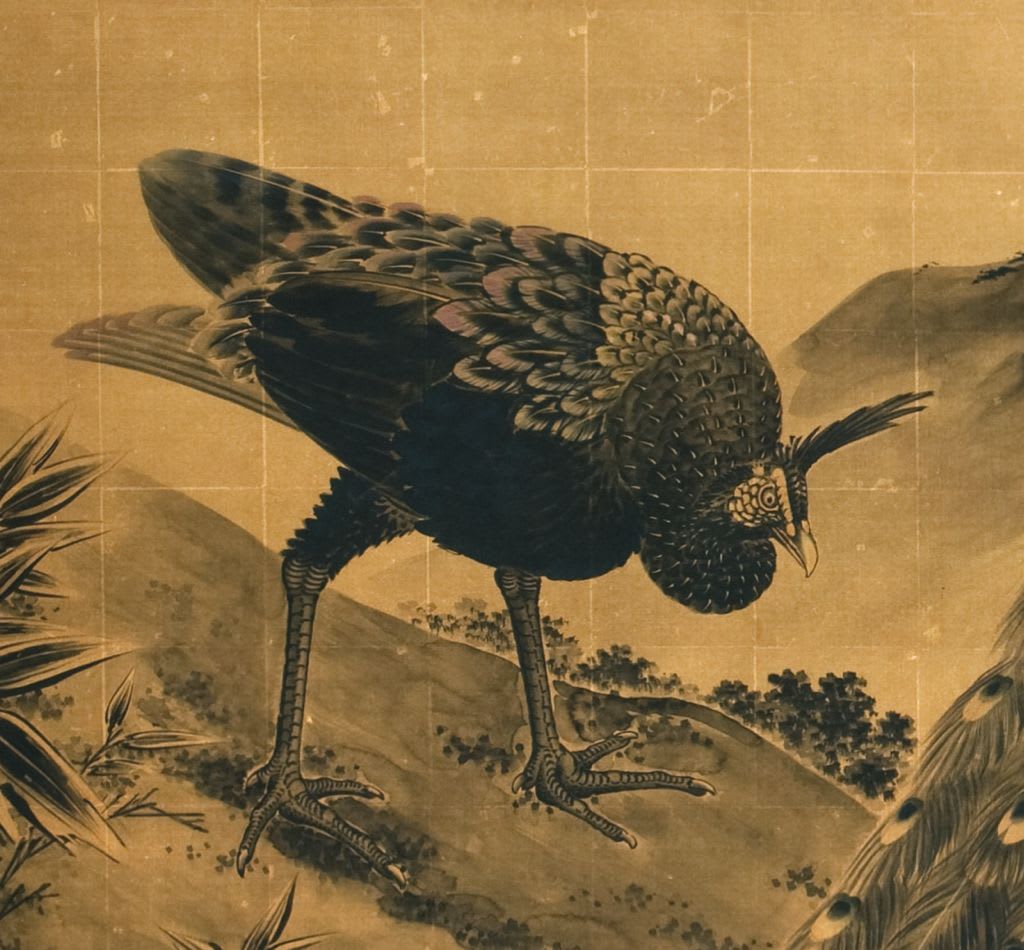Araki Kanpo
Peacock Pair, 1907
Two-panel folding screen; ink, colors, gold and gold-leaf on silk
Size 76¾ x 75¾ in. (195 x 192.4 cm)
T-3357
Further images
Signature: Kampo Seals: 1) »Seventy-seven year old Kampo« 2) »Artist name Tatsuan« A majestic peacock stands on top of a craggy cliff and surveys the world around him, while his...
Signature: Kampo
Seals:
1) »Seventy-seven year old Kampo«
2) »Artist name Tatsuan«
A majestic peacock stands on top of a craggy cliff and surveys the world around him, while his mate walks below, in the safety of his alert gaze. The painting was made by one of the great artists of modernizing Japan at the age of seventy-seven. Despite his advanced age, we sense the strength of the artist in the dramatic brushstrokes, the clear sense of composition, and the finely delineated techniques. Just like the male peacock, he still very much rules his corner of the world.
The sumptuousness and vitality of the peacock are reflected in the rich gold-leaf ground and in the fine details Kampo added with gold wash on top of the ink. He also added light colors to give depth to the plumage of the birds and drew the rocks and the bamboo with an array of textured strokes and ink wash techniques. In all these aspects, the painter goes back to a long tradition of peacock paintings on gold ground, such as those created by the Maruyama and Kishi Schools.
Kampo was born in Edo and started to work at an early age as apprentice for the Araki workshop, where he showed early promise. He was eventually adopted into the Araki family at the age of twenty-two and became its head painter. At one time he attempted oil paintings, but eventually returned to the Nihonga school style. Kampo specialized in paintings of flowers and birds. He unified the various styles and introduced new influences and techniques from the West, and taught a generation of young artists, becoming an important pioneer of the new age of painting in Meiji Japan.
Remarkably, Kampo had extensive success outside of Japan and became one of the most famous Japanese artists in the West. He entered works and won numerous prizes at international expositions, such as Vienna in 1872, Chicago in 1893, Paris in 1900, St. Louis in 1904, and London in 1910. He was also the first Japanese artist to become a member of the prestigious Royal Society of Arts in London. Inside Japan, he was very active in national exhibitions and won numerous honors. He taught at the Tokyo Art School from 1898 to 1908 and at other universities as well. The present screen stems from the time he was teaching at the Tokyo Art School.
Seals:
1) »Seventy-seven year old Kampo«
2) »Artist name Tatsuan«
A majestic peacock stands on top of a craggy cliff and surveys the world around him, while his mate walks below, in the safety of his alert gaze. The painting was made by one of the great artists of modernizing Japan at the age of seventy-seven. Despite his advanced age, we sense the strength of the artist in the dramatic brushstrokes, the clear sense of composition, and the finely delineated techniques. Just like the male peacock, he still very much rules his corner of the world.
The sumptuousness and vitality of the peacock are reflected in the rich gold-leaf ground and in the fine details Kampo added with gold wash on top of the ink. He also added light colors to give depth to the plumage of the birds and drew the rocks and the bamboo with an array of textured strokes and ink wash techniques. In all these aspects, the painter goes back to a long tradition of peacock paintings on gold ground, such as those created by the Maruyama and Kishi Schools.
Kampo was born in Edo and started to work at an early age as apprentice for the Araki workshop, where he showed early promise. He was eventually adopted into the Araki family at the age of twenty-two and became its head painter. At one time he attempted oil paintings, but eventually returned to the Nihonga school style. Kampo specialized in paintings of flowers and birds. He unified the various styles and introduced new influences and techniques from the West, and taught a generation of young artists, becoming an important pioneer of the new age of painting in Meiji Japan.
Remarkably, Kampo had extensive success outside of Japan and became one of the most famous Japanese artists in the West. He entered works and won numerous prizes at international expositions, such as Vienna in 1872, Chicago in 1893, Paris in 1900, St. Louis in 1904, and London in 1910. He was also the first Japanese artist to become a member of the prestigious Royal Society of Arts in London. Inside Japan, he was very active in national exhibitions and won numerous honors. He taught at the Tokyo Art School from 1898 to 1908 and at other universities as well. The present screen stems from the time he was teaching at the Tokyo Art School.
Publications
Catalog 2010.04











